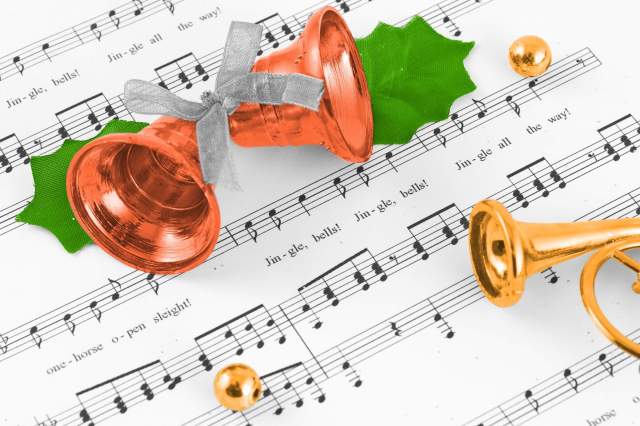
“Silent Night”
Legend says that an Austrian priest hastily whipped up this classic for his parishioners to sing after mice chewed through the church organ, but the truth is decidedly less dramatic. Having already crafted a poem titled “Stille Nacht,” Father Joseph Mohr enlisted schoolteacher and musician Franz Xaver Gruber to compose an accompanying melody on guitar for a performance at Christmas Mass in 1818. Enthusiasm for this simple but powerful piece steadily spread across Europe and overseas, which prompted an English translation by New York Episcopal priest John Freeman in 1859, before both German and English troops famously sang the song during a WWI Christmas ceasefire in 1914.

“Jingle Bells”
This ode to outdoor wintertime fun may have been composed in the warm-weather locale of Georgia — despite the claims of a city in Massachusetts. All aside, historians agree that the song was the work of James Lord Pierpont (uncle of Gilded Age tycoon J.P. Morgan), who copyrighted it in 1857 under the title of “One Horse Open Sleigh.” First recorded in 1889, “Jingle Bells” never achieved the massive sales recorded by some of the other standards on this list, though it does have the unique distinction of being performed in space in 1965.

“Santa Claus Is Coming to Town”
Tin Pan Alley writer Haven Gillespie wasn’t feeling the holiday spirit after attending his brother’s funeral in September 1934, but he nevertheless agreed to write a children’s Christmas song at the urging of his publisher. Riding the subway after the meeting, Gillespie started reminiscing about his mother’s warnings that St. Nick was monitoring his behavior, and within 15 minutes he’d scribbled the lyrics for “Santa Claus is Coming to Town” for composing partner J. Fred Coots. Popular entertainer Eddie Cantor took it from there by singing the ditty on his Thanksgiving radio show, and a holiday standard immediately took root.
More Interesting Reads

“Rudolph the Red-Nosed Reindeer”
Tasked with penning a story for a department store Christmas giveaway in 1939, copywriter Robert L. May took a page from the 1823 poem “A Visit from St. Nicholas” and created a now-familiar tale about a reindeer who saves the day with his distinct snout. The book reached some 2 million customers, but true fame only arrived after May reclaimed rights to the story and passed it on to songwriter Johnny Marks the following decade. By the time the song landed in the lap of Gene “the Singing Cowboy” Autry in 1949, there was no slowing its rise to the top of the Billboard charts in early 1950 and Rudolph’s ascent to the firmament of Yuletide culture.

“Have Yourself a Merry Little Christmas”
First sung by Judy Garland in 1944’s Meet Me in St. Louis, “Have Yourself a Merry Little Christmas” nearly missed out on its prominent introduction to the world. Writer Hugh Martin’s early draft had to be rescued from the trash by partner Ralph Blane, and it was subsequently fleshed out with such depressing lyrics that Garland refused to sing them. Martin grudgingly made the changes to satisfy Garland and director Vincente Minnelli, only to tweak the lyrics again to provide something more “jolly” for a 1957 Frank Sinatra rendition. Both the original and Sinatra versions have since been re-recorded many times over, by artists ranging from James Taylor to Twisted Sister.

“White Christmas”
Another holiday classic with Hollywood roots, this Irving Berlin-composed reflection on the timeless joys of the season was originally earmarked for an earlier project before surfacing in 1942’s Holiday Inn. And while Berlin felt that “Be Careful, it’s My Heart” would be the film’s biggest hit, it was the Bing Crosby-crooned “White Christmas” that instead grabbed listeners and claimed an Oscar in 1943. But even that achievement barely hints at its impact, as Crosby found an insatiable audience for the song while performing for American troops overseas. Along with fueling a 1954 movie of the same name, as well as covers by Elvis Presley, Bette Midler, Michael Bublé, and many other stars, Crosby’s “White Christmas” stood as the best-selling single of all time until Elton John’s “Candle in the Wind 1997.”












